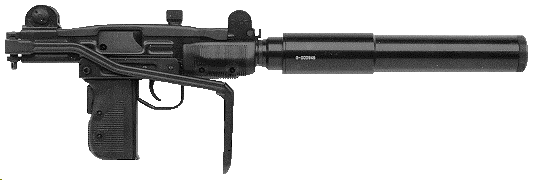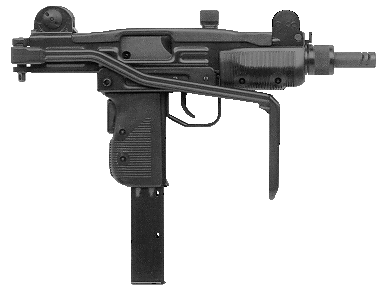


In Praise of the Mini-UZI
by Chuck Taylor
|
Extensive world-wide use of the UZI submachine gun has assured it a
place, perhaps even of reverence, in the annals of small arms history.
Indeed, this gun bearing its inventor's nickname has during its career
thus far seen service in one capacity or another with almost everyone's
military or police forces. Even the prestigious U.S. Secret Service utilizes
it to guard government officials, including the President of the United
States.
Yet, nothing is so perfect that cannot bear improvement or mutation into a "family" of arms and so is the case with the UZI. Israel Military Industries are offering to military and police agencies a "chopped and channeled" version of the UZI. Known simply as the "Mini-UZI," the gun retains all of the positive features of its bigger brother and, as well, sports a few innovations of its own. Word of the creation and development of the Mini-UZI had existed unofficially for several years and most ordnance-oriented personnel asked repeatedly the question of "why?"-why a mini UZI? What does such a weapon do that a regular UZI cannot? As might be expected, the answer varies, depending upon whom you ask, but my sources in Israel tell me that the primary idea was to utilize the best characteristics of the standard UZI (with which the Israelis have had well documented success when they used it properly) in a smaller arm for special operations and "firing port weapon" functions. Even a cursory visual inspection of the gun suggests that it could well fulfill all such applications. Actual fieldtesting completely confirms the thesis. Size Advantages
It is able to accomplish this by incorporating an excellent hinge design that precludes "wobble" when the stock is extended and a stock itself that is constructed of heavy steel rod and designed to force a proper stock-weld for shoulder-fire applications. Good show! The "hands-find-hands" magazine release, grip safety, actuator ratchet and selector switch of the original UZI have been retained. I find the mag release, ratchet and grip safety to be excellent, but the stiffness and pronounced edges of the selector switch are an impossible combination to master. Naturally, one can modify it to allow manipulation with less "oomph" required and polish off the edges, but it would be nice if the factory would perform these important functions, because they are universally important to everyone, regardless of his mission. Cyclic Rate Those who have UZIs (and this includes me) say that the 500 rmp cyclic rate is a dream and does not require manipulation of the selector switch to get single shots. Yep, that is indeed true - of the standard UZI. The new Mini-UZI is a first-class "rip snorter" in that its cyclic rate is in excess of 1,000 rpm - 1,200 rpm being the case with mine. Simple trigger manipulation, although both good technique and logistically sound, just won't suffice with a cyclic rate this high. This is why the stiffness of and edges on the selector switch are serious criticisms. Unique to the Mini-UZI are a front sight that uses a spring-detent and ratchet assembly to allow adjustment instead of the threaded post with lock-ring prevalent on the standard model. Also present is an adjustable rear sight that uses the same improved (read simpler, smaller and flatter) adjustment tool as the front sight instead of a bulkier front sight tool and a screwdriver as required on the standard gun. Again - bravo! A further improvement should be to arrange adjustment of both front and rear sight without tools of any kind. Accomplishment of this would really put the gun miles ahead, and let's hope such an improvement will be forthcoming in the not-too-distant future. Also new is a two-vent muzzle brake for the obvious purpose of assisting in full-auto control of the weapon. The standard brake is, at best, minimally effective and, in my opinion, should be abandoned and replaced with suppressor threads to allow the possibility of an additional category of potential applications. Clearly, the high cyclic rate of the Mini-UZI, along with its compactness, illustrates the intent of its builders to allow it both covert and special operations capability. Fitted with sound-suppressor threads, the "mini" could strongly rival the Ingram M-10 and 11 for such roles. Assembly/disassembly procedures for the new gun are the same as its parent and demonstrate the same ruggedness and simplicity of the full-sized gun. Accuracy & Control Shoulder employment of the Mini-UZI produced substantially superior results, both on the range and in the field, to those produced by the regular UZI, but close-range full-auto work proved to be more difficult due to the tremendously high cyclic rate and sharp angle of the grip in relation to the gun's receiver. On the other hand, a bit of familiarization helped a lot to reduce the problem and, if one views the picture from a truly objective standpoint, the target was still shot to ribbons, even if we did shoot up a bit more ammunition in the process! Thus, perhaps the problem is more theoretical than real. Also interesting was that in spite of the somewhat flimsy appearance of the buttstock, both underarm and shoulder work was easily facilitated with no loss in speed. Simple design? Yes, but still efficient. This, too, is an important disclosure that the gun's designers were paying attention. All in all, the new Mini-UZI is an interesting gun that shows considerable versatility and the potential to completely replace altogether its big brother, the standard UZI. I make no secret of the fact that I like the UZI SMG very much, for it has earned my respect by virtue of a battlefield performance record that rivals even the venerable Thompson and MP-40. Few arms approach, much less achieve, this level of notoriety and the fact that the UZI has done so speaks more or less for itself. I feel that the Mini-UZI is thus a fitting successor to the standard version and will "stand tall" among its competitors for years to come. A "slob's weapon"? Hardly. My only other criticism is that I wish its cyclic rate was in the same range as the full-sized UZI, for this would preclude entirely the manipulation of the safety/selector switch; an ability that I feel strongly enhances weapon acquisition speed and is, therefore, important. Other than this and previously mentioned comments, I give the Mini-UZI a clean bill of health.
first published in the March 1993 edition of Guns and Weapons for Law Enforcement |
 While overall length (stocks extended) of both the "mini" and standard
UZI are within an inch of each other, the mini-version is a good deal
shorter with stock folded (14.4 inches/36 cm versus 17.9 inches/47 cm).
The full-sized UZI with fixed wooden stock is 25.2 inches/64 cm long,
almost 11 inches/27.5 cm more than the mini-UZI. The standard UZI
folding stock leaves a great deal to be desired in that consistent,
comfortable stock-welds are a virtual impossibility, a problem the
fixed-stock versions do not share. But to obtain decent sighting
at speed, one has up to now been forced to accept the increased
length and bulk of the fixed-stock gun. When you are crammed
into an armored personnel carrier or aircraft with a full complement
of men and personal equipment, this becomes a major headache!
The new Mini-UZI solves the problem by providing decreased bulk
and length without sacrificing the superiority of the old fixed buttstock.
While overall length (stocks extended) of both the "mini" and standard
UZI are within an inch of each other, the mini-version is a good deal
shorter with stock folded (14.4 inches/36 cm versus 17.9 inches/47 cm).
The full-sized UZI with fixed wooden stock is 25.2 inches/64 cm long,
almost 11 inches/27.5 cm more than the mini-UZI. The standard UZI
folding stock leaves a great deal to be desired in that consistent,
comfortable stock-welds are a virtual impossibility, a problem the
fixed-stock versions do not share. But to obtain decent sighting
at speed, one has up to now been forced to accept the increased
length and bulk of the fixed-stock gun. When you are crammed
into an armored personnel carrier or aircraft with a full complement
of men and personal equipment, this becomes a major headache!
The new Mini-UZI solves the problem by providing decreased bulk
and length without sacrificing the superiority of the old fixed buttstock.